| ||||||||||||||||||
| ||||||||||||||||||
| ||
| Satellite image courtesy Jacques Descloitres, MODIS Land Rapid Response Team, NASA/GSFC. Taken October 29, 2002. | ||
|
The 2003 Antarctic Total Solar EclipseNovember 23, 2003
|
My hobby of chasing solar eclipses to remote corners of the globe continued this fall with a trip to Antarctica. I was part of the Astronomical Tours expedition to the Schirmacher Hills area, on the Princess Astrid Coast in Dronning (Queen) Maud Land, Antarctica. This area is near the coast of the continent, south of South Africa.
What is a total solar eclipse? Well, through an amazing coincidence in geometry, every few years the Moon blocks out the Sun creating a solar eclipse. The Sun is 400 times the size of the Moon, and 400 times as distant, so they appear to be the same size when viewed from Earth. When the orbit of the Moon takes it between the Sun and the Earth, the shadow of the Moon is cast upon the Earth. If the Moon is close enough to the Earth, someone located near the middle of that shadow will see the Moon exactly block out the Sun in a spectacular show. This is a "Total Solar Eclipse", arguably the most spectacular show in astronomy. Total Solar Eclipses (TSEs) happen every few years, in strips laid across seemingly random parts of the globe. Click here for a map of TSEs during 2001-2025, courtesy Fred Espenak of NASA.
At right is a satellite image of the area I visited. This map covers roughly 300km (200 miles) from top to bottom, and North is to the upper left. A red X marks the site where I observed the eclipse from. The area is in among the Institut Geologii Arktiki Rocks. The cigar shaped rock outcrop just above the X is the Schirmacher Oasis, where the Russian Novolazarevskaya base and the Indian Maitri base are located. I overflew the bases, but didn't have time for a ground visit. Between the Oasis and the X is the ice runway I landed on. The darker blue color is bare exposed ice, the snow has been blown off by the fierce katabatic winds. At top left is the ocean, littered with sea ice and icebergs. Just inland at the top middle is India's old Dakshin Gangotri base (too small to be visible in this image). Near the bottom left of the image in a small bluish patch is the Blue-1 ice runway. At bottom right are the Wohlthat / Drygalski Mountains. The lower-right-most mountain in the image is about where the Lazarev meteorite was found. It was the first iron meteorite found in Antarctica, in 1961. I don't know of any meteorites found in the area since then.
I have written a book-style account of the trip, covering the entire trip in detail. The information in this PDF file encompasses everything on this website, so you can download the PDF to read later and not miss anything! Feel free to print this out if you prefer to read it on paper. Please choose a resolution:
During the trip I posted almost-daily updates here and here. These links are being kept for historical reasons; the PDF report above is preferred.
A slideshow of my images from the entire trip is available here, hosted by Astronomical Tours.
Please bookmark this page and check back as more photos, video, and stories of the trip are coming.
After dinner (horrible cold tasteless stuff) we headed for the eclipse site. I went in the advance team with Vic & Jen Winter, David & Wendee Levy, Bob Shambora, and some other folks I don't know. We drove in a tracked vehicle that belongs to the Indians, a slow vehicle that took an hour to make the trip.

Upon arriving at the site there was a problem, South wasn't where it was when Jen surveyed the site in February. A large rise would block our view of the eclipse. To come all this way, spend all this money, have perfect weather, and miss the eclipse because of a snowbank would not do. We could not move south or west due to crevasses. East was no better. So that left north, we started hiking that way in the hope that as we got further from the ridge we would see over it better. We arrived at a suitable place only about 30 minutes before totality.
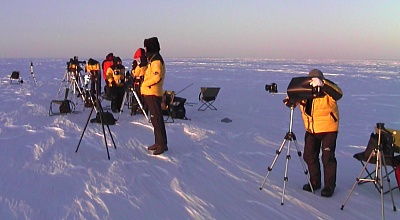 There was no time left to set up all of the equipment I had brought, so I had to prioritize and set up whatever I could. It was so bone-chillingly cold that batteries and cameras were dying left and right. Put a fresh battery in and it's dead within minutes. My fancy Meade LXD55 tracking mount decided it was in the northern hemisphere and refused to track the sun in the correct direction. Oh well.
There was no time left to set up all of the equipment I had brought, so I had to prioritize and set up whatever I could. It was so bone-chillingly cold that batteries and cameras were dying left and right. Put a fresh battery in and it's dead within minutes. My fancy Meade LXD55 tracking mount decided it was in the northern hemisphere and refused to track the sun in the correct direction. Oh well.
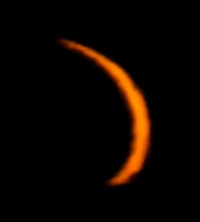 Standing next to me (to my right) was David & Wendee Levy, next to them was Jen & Vic Winter, then Bob Shambora, Karen Mendenhall, and finally Jim Huddle. To my left were Charles Simpson, Casper Badenhorst, and perhaps a few more people. We made sure to stand line-abreast so as not to get in each other's way.
Standing next to me (to my right) was David & Wendee Levy, next to them was Jen & Vic Winter, then Bob Shambora, Karen Mendenhall, and finally Jim Huddle. To my left were Charles Simpson, Casper Badenhorst, and perhaps a few more people. We made sure to stand line-abreast so as not to get in each other's way.
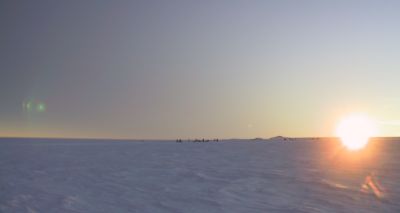 The seeing was absolutely terrible, on the order of several arcminutes. Extinction was about two stops (25% of the Sun's light was making it through the atmosphere, a really large amount and a testament to the extremely clean air here). David Levy spotted shadow bands around 10 minutes before totality, an exceptional amount of time. This is the first time I have ever seen shadow bands. They looked like a shadow of smoke. We could see the Moon's shadow coming in well to the left of the Sun (see right, darkening of sky). The anti-solar shadow was huge and black all the way to the horizon, I wish I could have gotten a picture of that (the camera died due to cold).
The seeing was absolutely terrible, on the order of several arcminutes. Extinction was about two stops (25% of the Sun's light was making it through the atmosphere, a really large amount and a testament to the extremely clean air here). David Levy spotted shadow bands around 10 minutes before totality, an exceptional amount of time. This is the first time I have ever seen shadow bands. They looked like a shadow of smoke. We could see the Moon's shadow coming in well to the left of the Sun (see right, darkening of sky). The anti-solar shadow was huge and black all the way to the horizon, I wish I could have gotten a picture of that (the camera died due to cold).
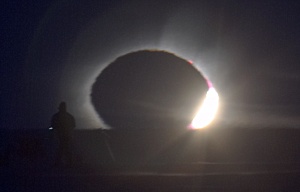 As totality approached I blindly took pictures with my cameras, hoping to get something. Because we had backed up from the designated observing site there was someone in my field of view. You can see him just left of the sun. This is the second contact diamond ring, you can see some red prominences and whitish corona. I have corrected the color to remove the reddening that comes from the low solar altitude, to better show the prominences. The ridge was still high enough to block part of the sun.
As totality approached I blindly took pictures with my cameras, hoping to get something. Because we had backed up from the designated observing site there was someone in my field of view. You can see him just left of the sun. This is the second contact diamond ring, you can see some red prominences and whitish corona. I have corrected the color to remove the reddening that comes from the low solar altitude, to better show the prominences. The ridge was still high enough to block part of the sun.
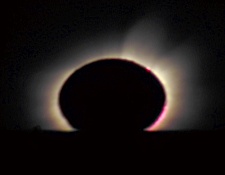 Just after second contact we could see some nice prominences. The wind was so strong that it shook my sturdy mount and blurred many of my images. The sharpest photos I have come from my video camera, as shown at right. This image is an average of the 30 best frames in two seconds of video. I used a JVC JY-HD10U hidef video camera (set to SD mode: 852x480x60fps progressive), with a 3X Kenko teleconverter, and Registax software to select and average frames. Then curves, saturation, and resize in Photoshop.
Just after second contact we could see some nice prominences. The wind was so strong that it shook my sturdy mount and blurred many of my images. The sharpest photos I have come from my video camera, as shown at right. This image is an average of the 30 best frames in two seconds of video. I used a JVC JY-HD10U hidef video camera (set to SD mode: 852x480x60fps progressive), with a 3X Kenko teleconverter, and Registax software to select and average frames. Then curves, saturation, and resize in Photoshop.
Totality was wonderful, I concentrated on observing visually while working cameras with the back of my mind. My binoculars were out of focus and I had a hard time adjusting them because of the cold. Looking around, I did not see any aurora. There was some spatial variation in sky brightness but nothing I would consider aurora. I could only see two radii of corona. The corona was orange or brown near the horizon, changing to a greenish tinge up higher.
The framed image below is a highly processed composite of four images that's intended to be a more artistic representation of what the eclipse felt like. I have increased the color saturation slightly to better show the green thru red corona colors, otherwise the image is truthful. (For an unprocessed single image click here, or here for a detailed explanation of how the image was created.) In the processed image the coronal streamers and polar brushes really come out. The person in the photo is the Japanese painter and illustrator Kagaya. He was set up directly in front of me. I didn't notice him before the eclipse because of the intense sunlight, so it was a complete accident that he was in my photo. At left is his "freight bag", a large soft suitcase in which we placed our cold weather gear, tripods, and so forth. Next to that is a collapsible chair, with his sleeping bag laying on it. At the moment of this photo he was leaning over to take a picture with his camera. I am very happy that Kagaya was in my photo, it makes the composition much more interesting.
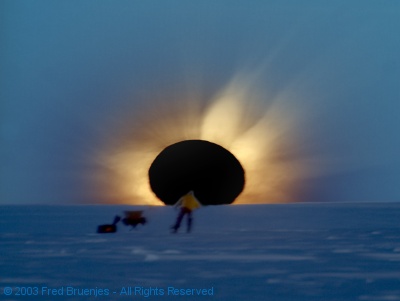 |
 Please click here for an MP3 sound recording of totality (2.6MB). The rumbling noise is from the wind.
Please click here for an MP3 sound recording of totality (2.6MB). The rumbling noise is from the wind.
I could tell the eclipse was coming to an end, because some prominences popped out from behind the Moon at the left edge. This video capture (using same method as video image above) was taken just before the eclipse ended at third contact. The eclipse took place about 15 minutes after local midnight, so the Sun was rising during totality. In this photo you can see how more of the corona was visible than at second contact (compare the distance between the "points" where the horizon meets the Sun: they are now closer than in the photo above).
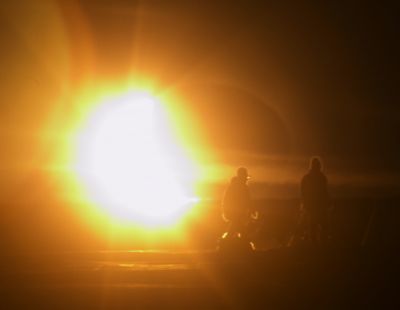 All too soon the eclipse ended and the sun peeked out from behind the moon. The third contact diamond ring is at left, you can still see a hint of corona around the left guy. Shadow bands again were visible for 10 minutes after totality. We were absolutely elated, we had done it! We (well, several hundred of us) became the first people to see a total solar eclipse from Antarctica. A whole continent, 6 billion people in the world, and we were the first ones. Amazing! This also marks the first time I've seen the midnight sun, as the eclipse was just after midnight local time.
All too soon the eclipse ended and the sun peeked out from behind the moon. The third contact diamond ring is at left, you can still see a hint of corona around the left guy. Shadow bands again were visible for 10 minutes after totality. We were absolutely elated, we had done it! We (well, several hundred of us) became the first people to see a total solar eclipse from Antarctica. A whole continent, 6 billion people in the world, and we were the first ones. Amazing! This also marks the first time I've seen the midnight sun, as the eclipse was just after midnight local time.
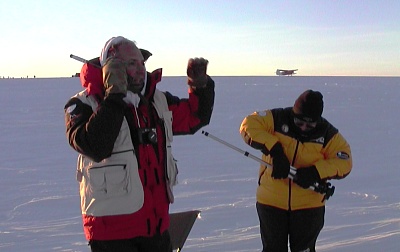 As I packed up my equipment (pretty much everything had died from the cold, no point in sticking around), David made a call in to the Discovery Channel for a live interview and related his descriptions with schoolboy giddiness.
As I packed up my equipment (pretty much everything had died from the cold, no point in sticking around), David made a call in to the Discovery Channel for a live interview and related his descriptions with schoolboy giddiness.
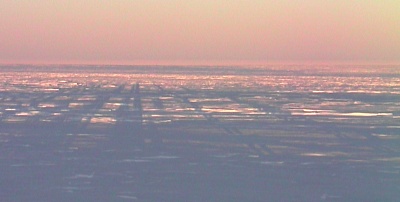 Before leaving I took a few moments to stop and just soak in the place. To borrow Astronaut Buzz Aldrin's words, it was a place of magnificent desolation, as barren and inhospitable as the Moon he walked on 34 years ago. I really feel like an astronaut. Our mission started with training, progressed to space suit fit checks (cold weather clothing), aborted liftoffs (weather delays), finally a real liftoff (the Russian cargo flight), a landing, and a successful fulfillment of our mission. Would there be a tickertape parade when I returned home to San Diego? Of course not, what was I thinking. As I stood there on the ice I was overcome, I tried to express my feelings to those around me but I couldn't find the words. "Unbelievable" was what came to mind. This place was simply unbelievable. As I looked north and followed my long shadow up to the horizon I noticed that the horizon seemed to stretch forever (see photo at left). In the dry pristine air we were seeing perhaps a hundred miles, all the way to the distant ice covered ocean. I just could not believe where I was.
Before leaving I took a few moments to stop and just soak in the place. To borrow Astronaut Buzz Aldrin's words, it was a place of magnificent desolation, as barren and inhospitable as the Moon he walked on 34 years ago. I really feel like an astronaut. Our mission started with training, progressed to space suit fit checks (cold weather clothing), aborted liftoffs (weather delays), finally a real liftoff (the Russian cargo flight), a landing, and a successful fulfillment of our mission. Would there be a tickertape parade when I returned home to San Diego? Of course not, what was I thinking. As I stood there on the ice I was overcome, I tried to express my feelings to those around me but I couldn't find the words. "Unbelievable" was what came to mind. This place was simply unbelievable. As I looked north and followed my long shadow up to the horizon I noticed that the horizon seemed to stretch forever (see photo at left). In the dry pristine air we were seeing perhaps a hundred miles, all the way to the distant ice covered ocean. I just could not believe where I was.
The trip was definitely worth it. I got to see an amazing show in an amazing place, and I got to know some really interesting people. The next total solar eclipse will be near Tahiti in April 2005, and I will surely be there. The antithesis to this Antarctic eclipse will come in 2006 when we converge on the Sahara Desert!
Please visit my main astronomy page, or check out my homepage.
Comments? Questions? Click here to send email to me, Fred Bruenjes.
All text and images are © 2003 Manfred Bruenjes - All Rights Reserved. Image inlining (aka hot linking) and framing are strictly prohibited. Email for permission before using an image or text.